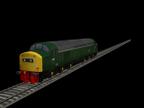English-Electric Type 4 - Class 40
|

Rolling Stock |

|
| Status: |
Final Release |
| Last Update: |
Mon Apr 26 2004, 01:01pm |
| Leader: |
sdark - Steve Dark |

United Kingdom |
| Team: |
Me - 3D Model
Tony Meredith - Textures |
|
|
The English Electric Type 4 (British Rail Class 40 "Whistler") is arguably the most significant locomotive of modern British diesel-electric motive power.
The Class 40 was first concieved back in 1947 when LMS decided to produce a Main Line diesel-electric loco. This first loco was produced using proven steam traction principles and was styled with an American influence in that it had nose ends with two driving cabs and a Co-Co wheel arrangement.
This loco went on to prove it worth on the Manchester - Derby - St Pancras passenger services. It was then joined by a sister loco in 1948. They continued their trial period until 1951 at which point they entered regular main line passenger service duties on the London Midland Region.
Meanwhile, the Southern Region began to build three prototypes. The internal layout of the locos were different to the LMS versions. They had a flat-fronted design and rode on cast frame bogies with a 1Co-Co1 wheel arrangement to reduce axle loading.
The third loco was held back from production whilst testing for the other two was undertaken and finally emerged in 1954. This loco was only 132 tons (a great deal lighter than any of the previous versions) and had a newer 2000hp power unit. By 1957 the locos were returning more than twice the annual mileage of a similar powered express steam loco.
In 1955 British Railways implemented the start of its Modernisation Scheme. In applying this to motive power, they ordered 174 diesel prototype locos from various UK manufacturers, to evaluate the most suitable types over a three year trial period. Power classification became a numbered sequence, Types 1 to 5 with Type 4 covering 2000 - 2999hp. For their bid, English Electric proposed a 2000hp loco based on the layout of the Southern Region's version but with the body styling of the first LMS version. British Rail placed an order and the first Main-Line Diesel-Electric Type-4 loco came to be.
The first 10 prototypes were accepted into BR stock in early 1958 and after acceptance trials and various crew-training work its first well-documented demo run was on 18 April 1958 from London Liverpool Street to Norwich.
Of the first 10 EE Type 4s, half were allocated to the Great Northern Region and half to the Great Eastern Region. The GNR machines worked out of Kings X to Sheffield, Newcastle and Edinburgh, covering such famous named trains as the "Flying Scotsman" and the "Master Cutler". The GER locos were employed on upgraded services from Liverool Street to Cambridge, Ipswich and Norwich.
The most famous class 40 was D326 (40126) and for the wrong reasons. In 1962, due to driver error, it collided with another train killing 18 people and injuring 33. On 8 August 1963 it was hauling the overnight West Coast Postal Service and became involved with the Great Train Robbery. In 1964 a secondman was electrocuted by the overhead wire while working outside the loco. Finally in 1965 the loco suffered total brake failure on approach to Birmingham New Street.
The Class 40 was the preferred loco for Royal Train duties from the late 1960's until 1977.
Unfortunately, as the 1970's drew to an end, the recession hit BR freight traffic hard. Continuing delivery of new Type 5 Class 56's and 58's enabled other motive power to be 'cascaded', so the Class 40's found less and less work. The first planned withdrawals had started in 1976 at which point The Whistlers (nicknamed from the distinctive turbo charger sound) gained a fanatical following. The following grew, ironically, with more and more locos being withdrawn, as enthusiasts tried to savour every chance to photograph or ride with them.
With enthusiasts frantically following every last move, the few surviving 'main fleet' of Whistlers were withdrawn en-masse in January 1985. D200 was the only Class 40 left in service and was finally withdrawn in April 1988 almost 30 years after it was first instroduced.
I know this brief is a little excessive but this is one my most favourite locos and I am known to waffle a bit! :)
|
|

